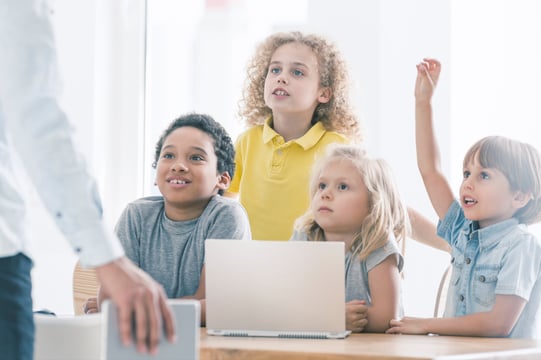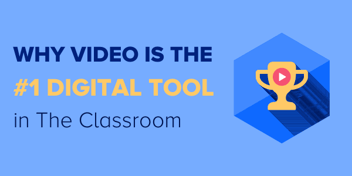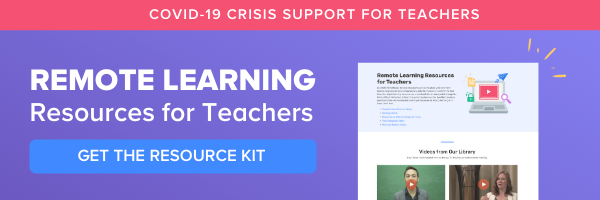The use of video in education isn’t what it was. It was once considered a rare treat for students when their teachers would roll the AV cart into the classroom and turn on a video for an hour or two of passive media consumption. Today, teachers use videos regularly, generally in bite-sized chunks, as an integrated part of their lessons. Rather than consuming them passively, students now actively engage with the content as their teachers facilitate activities and discussions centered around the video. Video is no longer just an occasional supplement: a recent survey shows that video streaming sites are the top digital tool teachers use in the classroom (Common Sense Media, 2019).
Just like every other shift in education, the change in teachers’ attitudes and behaviors didn’t just happen overnight. It’s also not reducible to a single cause. When we look at video usage in classrooms holistically, we can see three primary drivers that explain the seemingly sudden explosion of video in the classroom: technical, social, and pedagogical.
<<How do teachers use video in the classroom? Dig into the data with our report>>

Technical
Technology has made it easier to stream video in the classroom by increasing students’ and teachers’ access to the Internet. In 2013, just 25% of schools reported having sufficient classroom access to WiFi. In 2017, that number climbed to 88%, while 94% of schools meet the minimum connectivity target (source). With increased connectivity and higher bandwidth, teachers can quickly access high-quality videos without lessons being interrupted or slowed down.
The cost of digital devices has also decreased, putting more computers and tablets in classrooms, and giving more students access to media such as video. Not only does this make full-class participation easier, but improved access to devices for students allows for individual and group work. Multiple devices in the classroom mean that teachers can assign students different video resources to meet personal learning needs and facilitate collaboration, or students can engage in the same resource at their own pace.
Outside of a traditional classroom environment, technology arguably plays an even more important role. Many schools have switched to remote teaching in response to COVID-19 and technology allows learning to continue from home. Video is an effective way to engage students in their education when they’re facing the challenges and distractions that come with remote participation. Clips can be used to present new concepts, review learned skills, and even develop essay writing skills.
Read the post: 6 Ideas for Integrating Video In Virtual Learning >>
Social
Teachers seek to meet learners where they are, and today’s learners are deeply embedded in the world of digital media. The average 8-18 year-old consumes 6-9 hours of digital media each day, while over half of millennials and GenZers say they prefer to learn through video (source). Teachers know that to keep students with shortening attention spans focussed, they need to tap into the familiar and engaging technologies that students use every day (source). YouTube, Snapchat, TikTok, and other video apps are staples of youth media consumption and demonstrate that short, punchy videos are a student favorite.
It’s not just students whose preferences have changed. As technology begins to play a central role in our daily lives, teachers are growing in confidence when using it in their classrooms. Many younger teachers are millennials themselves and have grown up using video streaming sites, while many experienced teachers became early adopters in schools. As well as seeing positive impacts on student engagement and learning, 55 percent of teachers believe video helps them to be more creative and 62 percent say that they think video allows them to be more effective in their teaching (source).
Read the post: Proven Ways to Improve Student Learning with Video>>
Pedagogical
So what does being more effective in the classroom mean? There are four primary pedagogical benefits of using video in lessons: ease of differentiation, fostering global awareness and competitive worker skills, and developing critical problem solving skills (source).
Along with the previously mentioned capacity for students to learn at their own pace, video allows teachers to differentiate in other ways too. With a vast array of educational videos at their fingertips, teachers can select the most effective examples for their students. While some may need to have a concept clearly spelled out with an explainer video, others may benefit from seeing it in action in the form of an experiment, for example. The availability of transcripts and subtitles also help students who are hard of hearing or who simply prefer to be able to read along.
Read the post: A Guide to Differentiating The Learning Process with Video>>
Teachers also have the ability to utilize video in traditional classroom settings, or create flipped classrooms, or “blended” learning environments and facilitate remote learning opportunities where teachers can reach students around the globe. Learners comfortable with video platforms tend to remember and retain learned concepts over other instructional techniques.
Fostering global awareness can be difficult, especially for schools in remote or deprived communities. Without the need to even leave the classroom, teachers can introduce students to different cultures and points of view with the help of videos. Streaming technology can transport a class to places that they may not have the opportunity to go otherwise, allowing them to sit in on a UN conference, visit a tribe in the Amazon rainforest, or listen to the stories of holocaust surviours. Of course, there’s at least two sides to every story and showing students news reports from multiple sources or historical analysis from different historians allows them to develop critical thinking skills that are crucial for their learning and development.
As we look towards the future, familiarity with digital media tools is an important skill for workforce readiness. Regular technology use demystifies these tools, giving learners the confidence they need to utilize them in new contexts (source). Many industries now use technology, including video, for communication and collaboration so the ability to handle it with confidence is an important post-education skill.
The social, pedagogical and technological drivers of using video in the classroom cannot be denied. Students and teachers have immersed and embraced new technologies, making it imperative to match technological proficiencies of the students with tools and styles of learning they can relate to. With increased access to the internet and video taking center stage in how society learns and communicates on a global level, teachers using video are right on track with the evolving nature of the new standards of learning.
Boclips
Boclips is on a mission to make learning more captivating with video with an easier, safer way to access videos from the world’s leading video producers.
- #Video in Digital Learning
- #Classroom
- #Educational Videos
- #Video Content Partners
- #Tips for Using Video
- #Boclips for Publishers
- #Issues in Education
- #Educational Videos by Subject Area
- #News and Announcements
- #Events & Holidays
- #Video and Teaching Tools
- #Teaching Methodologies
- #Education Videos
- #Video and Digital Literacy
- #Short Educational Videos
- #Instructional Design
- #Multimodal Learning
- #Video and Student Safety
- #Accessibility in Education
-3.png?width=390&height=223&name=Untitled%20design%20(2)-3.png)


.png?width=1152&height=660&name=Copy%20of%20Untitled%20Design%20(1).png)




